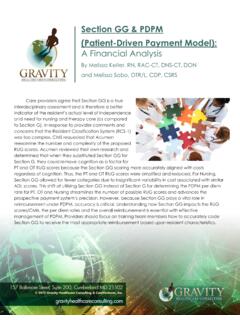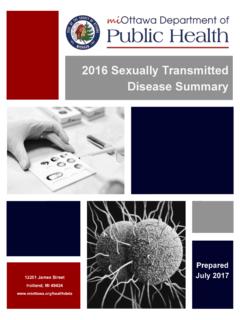Transcription of PDPM Financial Analysis - gravityhealthcareconsulting.com
1 PDPM Financial Analysis : Therapy Armageddon or Therapy Freedom? By Melissa Sabo, OTR/L, CDP, CSRS. Revised 9/24/18. As providers we breathed a sigh of relief when CMS informed us on April 27, 2018 that RCS-1. was being tabled in favor of a new, remodeled edition titled the Patient Driven Payment Model, or PDPM. And while PDPM shows many improvements over what was believed to be Therapy Armageddon in RCS-1, there are still many concerns in the therapy and skilled nursing world about what PDPM means for the future. With a significantly altered reimbursement structure for therapy services, many providers have considered drastic cuts in the amount of therapy services they intend to provide under PDPM. Furthermore, with CMS focused on a value over volume agenda, PDPM. encompasses a paradigm shift because skilled nursing and long-term care reimbursement is no longer powered by the amount ( minutes) of therapy services provided.
2 And, in fact, providers could theoretically increase their margins further by not providing therapy services because the community will continue to receive therapy reimbursement even if therapy services are not provided, though that is not recommended and would place the community at great liability. It is critical for every provider to become fully informed and prepared for PDPM by understanding that PDPM is 1. essentially a redistribution of reimbursement, how PDPM impacts in-house and contract rehab margins, the new risks for audits, denials and recoupments under PDPM and the imperative to partner with the right therapy services under PDPM. PDPM is essentially a redistribution of the reimbursement provided under RUGs-IV (See Table 1). Overall, CMS has stated that the impact of PDPM should be budget neutral, though it will not impact individual providers in the same way.
3 The key to understanding PDPM reimbursement is that approximately $500 million reduction in therapy reimbursement was shifted over to increase nursing reimbursement by $520 million. In the first draft of the proposed rule, there was a -$18 million reduction due to a missing therapy non-case mix component. While advocates have requested that CMS correct this error CMS has clarified that this therapy non-case mix was already distributed throughout the existing payment groups and will not be added to PDPM. And at the worst, it should be a sum-zero game even if providers do not change any of their behaviors. However, advocates have requested that CMS correct this error and if it is corrected, it will result in a potential increase by $20 million in revenue for the industry. And at the worst, it should be a sum-zero game even if providers do not change any of their behaviors.
4 However, history has proven that when CMS. changes the targets, initiatives and reimbursement structure, providers have adjusted behaviors to accommodate these changes. And organizations with thought leaders who implement a proactive strategy can leverage these regulatory changes to positively impact overall revenue while continuing to strive for clinical excellence and outcomes. 2. Table 1: Overall Financial Analysis of PDPM for all providers based upon NASL Analysis . However, PDPM is not intended to have the same impact on all providers. As would be expected with a completely new platform for reimbursement, some providers will come out ahead and some behind if they do not change any practices. From the CMS Analysis shown in Table 2, we note that for-profit entities are expected to see a loss of while non-profit providers should see a gain of Facilities with less than 100 beds are likely to see an increase in revenue up to , though larger facilities may see a modest reduction in reimbursement.
5 Communities with more than 200 beds stand to see the greatest loss of just under 2% with PDPM. Urban locations will see a reduction in reimbursement by while rural locations stand to see an increase of This Analysis is based upon MDS data that was submitted to CMS for several years and is based upon the associated case mix and resident characteristics of those historical MDSs. In analyses conducted by Gravity Healthcare Consulting on behalf of multiple clients, it has been noted that multiple errors in documentation or scoring on MDSs that didn't impact reimbursement under RUGs-IV would have a powerful impact under PDPM. For example, one resident who did not have a Section GG score that was consistent with what was in the documentation would receive an additional $ in reimbursement per day under PDPM for an accurate Section GG score. Two other residents who had the incorrect ICD-10 active diagnosis selected on the MDS would see an increase of $ or $ per diem if the correct ICD-10 code had been selected.
6 In approximately 75% of the MDSs audited by Gravity in June 2018, it was noted that coding or documentation errors would result in reduced and inaccurate per diem rates under PDPM. Providers need to be proactive now and implement PDPM-focused MDS audits, ICD-10. coding training for MDS coordinators, and robust nursing documentation auditing and training to prepare for PDPM. Also, Section GG ADL coding training for the nursing team, especially CNAs or GNAs, will be critical to successfully transition to PDPM as Section GG will now be the foundation for ADL coding (instead of Section G). 3. Table 2: CMS projected effects of PDPM versus RUGS-IV: Facility Characteristics from the Technical Expert Panel Report by Acumen. A Financial Analysis comparing the per diem rates of PDPM versus the reimbursement under RUGs-IV is enlightening. The bottom line is that there are no direct or exact correlations.
7 It is like trying to compare checkers and chess games . they are both played on a checkered board, but the playing pieces, rules and strategies for success are so vastly different that there are few parallels other than the playing board. In many of our analyses, residents that currently achieve RUs (Rehab Ultra High categories) can see a slight decrease under PDPM. However, this is not always the case, especially for residents who are medically complex, who might instead have an increased reimbursement under PDPM. And residents in the non-RU groups ( RV, RH, RM) often see a significantly higher reimbursement with PDPM as compared to RUGs-IV. For the first example in Table 3, the RUGs for PDPM and RUGs-IV along with reimbursements are shown for a resident with a hip replacement and a diabetic foot ulcer with no other major complications or issues. Under PDPM, if this resident had achieved an RU, it would result in a loss of $ per day.
8 By contrast, if that resident had only received an RV with RUGs-IV, the provider would see an increase in reimbursement by $ per day, or just over $2,000 in a typical 20-day stay. 4. Table 3: Comparison of per diem rates of RUGs-IV vs. PDPM for a resident with a hip replacement. In another example, a resident would fall into the Medical Management Rehab Category for PDPM due to an acute exacerbation of COPD, with a chronic diabetic foot ulcer and chronic dysphagia on a mechanically soft altered diet. For this resident, providers would see a significant jump in reimbursement with PDPM as compared to RUGs-IV. And, the reimbursement for an RV. (Rehab Very High) resident who received 500+ minutes per week of therapy services would see an even greater increased reimbursement of $ per day. This increased per diem revenue equates to almost $5,000 of additional revenue in a typical 20-day length of stay.
9 5. Table 4: Comparison of final per diem rates for RUGs-IV versus PDPM for a resident with COPD, chronic diabetic foot ulcer and chronic dysphagia. Stroke residents are another key outlier for consideration of the Financial Analysis of PDPM versus RUGs-IV. Residents with CVAs (cerebrovascular accidents) tend to be an outlier because they are likely to use most or all 100 days of skilled services, either from the ongoing provision of therapy and/or because of the likelihood of requiring enteral (tube) feedings. Additionally, CVA residents almost always require speech therapy services and often achieve an RU for a significant portion of the skilled stay. Table 5 shows the reimbursement for a resident who suffered from a right middle cerebral artery CVA who is totally hemiplegic on the left side of her body upon admission. She is unable to speak and unable to manage food or liquid and is receiving enteral feedings and is totally dependent for all care.
10 In this Analysis , the CVA resident would receive an increased reimbursement of $ per day as compared to an RU under RUGs-IV and an increase of $ per day for an RV. 6. Table 5: Comparison final per diem rates RUGs-IV versus PDPM for a resident with a stroke and left hemiplegia, dysphagia and a tube feeding. However, with a CVA resident or other residents who require more than 20 days of skilled care, PDPM presents a new challenge. Under PDPM, starting on day 21, the PT and OT reimbursement decreases by 2% every 7 days. Upon admission, this resident would qualify for a combined PT, OT and ST per diem rate of $ This means that at day 21 the combined therapy per diem rates for PT, OT. and ST would drop to $ By days 98-100, the skilled reimbursement would drop to the lowest rate of $ , or 76% of the per diem rate established upon admission. Another dramatic difference between PDPM and RUGs-IV is that under RUGs-IV, residents are always in an assessment due to the potential need for a COT at any assessment check point in between the established 5-day, 14-day, 30-day, 60-day and 90-day assessments.





